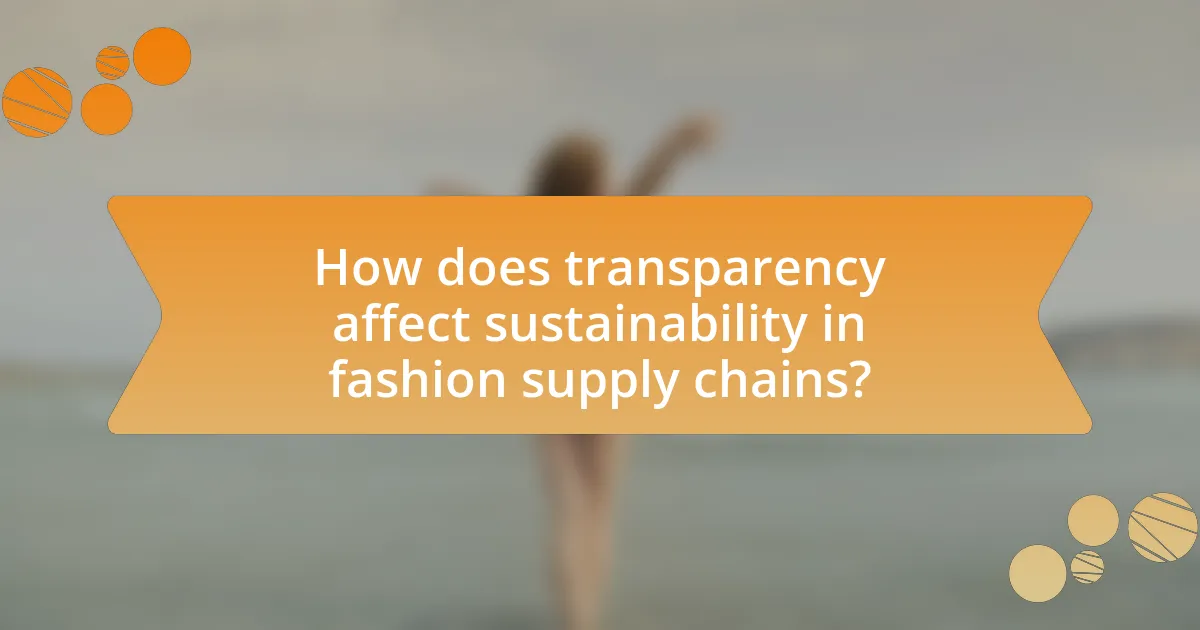The article focuses on the importance of transparency in fashion supply chains, emphasizing its role in promoting ethical practices and building consumer trust. It highlights the need for brands to disclose information about sourcing, production processes, and labor conditions to mitigate risks related to exploitation and environmental harm. Key components of transparency include traceability, ethical labor standards, and clear communication of environmental impacts. The article also discusses the challenges brands face in achieving transparency, such as complex supply chains and regulatory variations, while outlining strategies and technologies that can enhance visibility and accountability in the industry.

What is the Importance of Transparency in Fashion Supply Chains?
Transparency in fashion supply chains is crucial for fostering ethical practices and consumer trust. It allows stakeholders to trace the origins of materials, ensuring that labor conditions and environmental impacts are responsibly managed. For instance, a 2021 report by the Fashion Transparency Index found that only 40% of major fashion brands disclose their suppliers, highlighting a significant gap in accountability. By increasing transparency, brands can mitigate risks related to labor exploitation and environmental degradation, ultimately leading to more sustainable practices and informed consumer choices.
Why is transparency crucial in the fashion industry?
Transparency is crucial in the fashion industry because it fosters accountability and ethical practices throughout the supply chain. By providing clear information about sourcing, production processes, and labor conditions, brands can build trust with consumers who increasingly demand ethical and sustainable practices. For instance, a 2021 survey by McKinsey & Company found that 66% of consumers are willing to pay more for sustainable brands, highlighting the market demand for transparency. Furthermore, transparency helps to mitigate risks related to labor exploitation and environmental harm, as companies that disclose their practices are more likely to adhere to regulations and ethical standards.
What are the ethical implications of a lack of transparency?
A lack of transparency in fashion supply chains raises significant ethical implications, primarily concerning exploitation and accountability. When companies do not disclose their sourcing and production practices, it becomes difficult to ensure that workers are treated fairly and that environmental standards are upheld. For instance, the 2013 Rana Plaza collapse in Bangladesh highlighted the dangers of opaque supply chains, where workers faced unsafe conditions without any oversight due to a lack of transparency from brands. This incident resulted in over 1,100 deaths and sparked global outrage, emphasizing the need for ethical accountability in the industry. Furthermore, consumers are increasingly demanding transparency, as studies show that 73% of millennials are willing to pay more for sustainable products, indicating that ethical practices are not only a moral obligation but also a market necessity.
How does transparency impact consumer trust?
Transparency significantly enhances consumer trust by providing clear and accessible information about products and practices. When brands openly share details regarding their supply chains, sourcing, and manufacturing processes, consumers feel more informed and empowered in their purchasing decisions. Research indicates that 94% of consumers are likely to be loyal to a brand that offers complete transparency, as highlighted in the 2020 Global Consumer Insights Survey by PwC. This level of openness fosters a sense of accountability and integrity, leading to stronger emotional connections between consumers and brands.
What are the key components of transparency in fashion supply chains?
The key components of transparency in fashion supply chains include traceability, disclosure of sourcing practices, and ethical labor standards. Traceability allows consumers to track the origin of materials and the journey of products through the supply chain, ensuring accountability. Disclosure of sourcing practices involves brands openly sharing information about their suppliers and production processes, which fosters trust and informed consumer choices. Ethical labor standards ensure that workers are treated fairly and work in safe conditions, which is essential for maintaining a responsible supply chain. These components collectively enhance consumer confidence and promote sustainability within the fashion industry.
What information should brands disclose about their supply chains?
Brands should disclose information about their supply chains, including the origin of raw materials, manufacturing processes, labor practices, and environmental impact. Transparency regarding the sourcing of materials helps consumers understand the ethical implications of their purchases. For instance, brands should specify whether materials are sourced sustainably or from conflict zones. Additionally, detailing manufacturing processes, such as factory locations and working conditions, allows consumers to assess labor practices and compliance with human rights standards. Furthermore, brands should communicate their environmental policies, including waste management and carbon footprint, to inform consumers about their ecological impact. This level of disclosure not only builds consumer trust but also aligns with increasing regulatory requirements for transparency in supply chains.
How can technology enhance transparency in supply chains?
Technology enhances transparency in supply chains by enabling real-time tracking and data sharing among all stakeholders. For instance, blockchain technology provides an immutable ledger that records every transaction, ensuring that all parties can verify the authenticity and origin of products. According to a report by the World Economic Forum, implementing blockchain in supply chains can reduce fraud and increase trust among consumers, as it allows for complete visibility into the sourcing and movement of goods. Additionally, Internet of Things (IoT) devices can monitor conditions during transportation, providing data on temperature, humidity, and location, which further supports accountability and transparency.

How does transparency affect sustainability in fashion supply chains?
Transparency significantly enhances sustainability in fashion supply chains by enabling stakeholders to track and verify ethical practices throughout the production process. When brands disclose information about sourcing, labor conditions, and environmental impact, consumers can make informed choices, leading to increased demand for sustainable products. A study by the Global Fashion Agenda and McKinsey & Company highlights that transparency can reduce resource waste and improve supply chain efficiency, as companies are held accountable for their practices. Furthermore, transparency fosters collaboration among suppliers, manufacturers, and retailers, driving innovation in sustainable materials and processes.
What role does transparency play in sustainable practices?
Transparency is crucial in sustainable practices as it fosters accountability and trust among stakeholders. By openly sharing information about sourcing, production processes, and environmental impacts, companies enable consumers to make informed choices and encourage ethical behavior within the supply chain. Research indicates that brands with transparent practices are more likely to attract environmentally conscious consumers, as 66% of global consumers are willing to pay more for sustainable brands (Nielsen, 2015). This connection between transparency and consumer behavior reinforces the importance of clear communication in promoting sustainability within the fashion industry.
How can transparency help reduce environmental impact?
Transparency can help reduce environmental impact by enabling consumers and stakeholders to make informed decisions about sustainable practices in fashion supply chains. When companies disclose information regarding their sourcing, production processes, and environmental policies, it fosters accountability and encourages the adoption of eco-friendly practices. For instance, a study by the Global Fashion Agenda and The Boston Consulting Group found that increasing transparency in the fashion industry could lead to a reduction of up to 30% in greenhouse gas emissions by 2030. This evidence illustrates that transparency not only empowers consumers to choose sustainable brands but also pressures companies to improve their environmental performance.
What are the benefits of sustainable sourcing for brands?
Sustainable sourcing provides brands with enhanced reputation, cost savings, and compliance with regulations. By adopting sustainable practices, brands can improve their public image, as consumers increasingly prefer environmentally responsible products; a Nielsen report indicates that 66% of global consumers are willing to pay more for sustainable brands. Additionally, sustainable sourcing can lead to long-term cost reductions through efficient resource use and waste minimization. Furthermore, brands that prioritize sustainability are better positioned to meet regulatory requirements, reducing the risk of fines and enhancing operational resilience.
How does transparency influence labor practices in the fashion industry?
Transparency significantly influences labor practices in the fashion industry by promoting accountability and ethical standards among brands and suppliers. When companies disclose information about their supply chains, including labor conditions and wages, it enables consumers and watchdog organizations to hold them accountable for unethical practices. For instance, a 2020 report by Fashion Revolution found that 75% of consumers are more likely to support brands that are transparent about their supply chains, leading to increased pressure on companies to improve labor conditions. This transparency can result in better wages, safer working environments, and reduced exploitation of workers, as brands strive to maintain a positive public image and meet consumer expectations.
What are the risks of non-transparent labor practices?
Non-transparent labor practices pose significant risks, including exploitation of workers, legal repercussions, and damage to brand reputation. Exploitation occurs when companies fail to disclose working conditions, leading to violations of labor rights, such as inadequate wages and unsafe environments. Legal repercussions arise from non-compliance with labor laws, which can result in fines and lawsuits. Additionally, brands that lack transparency may face consumer backlash, as studies show that 66% of consumers are willing to pay more for sustainable brands, indicating that transparency is crucial for maintaining customer trust and loyalty.
How can transparency improve worker conditions?
Transparency can improve worker conditions by enabling accountability and fostering trust between employers and employees. When companies openly share information about labor practices, wages, and working conditions, it empowers workers to advocate for their rights and ensures that employers adhere to ethical standards. For instance, a study by the Ethical Trading Initiative found that transparency in supply chains leads to better compliance with labor laws and improved working conditions, as companies are more likely to address issues when they are publicly scrutinized. This openness not only enhances worker safety and satisfaction but also encourages a culture of responsibility within organizations, ultimately leading to a more sustainable and ethical fashion industry.

What challenges do brands face in achieving transparency?
Brands face significant challenges in achieving transparency, primarily due to complex supply chains and varying regulatory standards. The intricate nature of global supply chains often obscures the origins of materials and labor practices, making it difficult for brands to trace and verify every step of production. Additionally, inconsistent regulations across different countries can hinder brands’ ability to implement uniform transparency practices. For instance, a study by the Fashion Transparency Index indicates that only 40% of major fashion brands disclose their supply chain information, highlighting the difficulty in achieving full transparency. Furthermore, brands may encounter resistance from suppliers who are reluctant to share sensitive information, further complicating efforts to provide clear and honest communication about sourcing and labor conditions.
What are the common barriers to transparency in fashion supply chains?
Common barriers to transparency in fashion supply chains include complex supply chain structures, lack of standardized data, and resistance from stakeholders. Complex supply chains often involve multiple tiers of suppliers, making it difficult to trace the origin of materials and labor practices. The absence of standardized data formats hinders effective communication and sharing of information across different entities. Additionally, stakeholders, including manufacturers and brands, may resist transparency due to concerns about revealing sensitive business information or potential reputational risks. These factors collectively impede efforts to achieve greater transparency in the fashion industry.
How do cost and complexity affect transparency efforts?
Cost and complexity significantly hinder transparency efforts in fashion supply chains. High costs associated with implementing transparent practices, such as advanced tracking technologies and comprehensive auditing processes, can deter companies from pursuing these initiatives. For instance, a study by the Fashion Transparency Index indicates that brands often prioritize profit margins over transparency due to the financial burden of compliance and reporting. Additionally, the complexity of global supply chains, which involve multiple tiers of suppliers and varying regulations, complicates the ability to gather and share accurate information. This complexity can lead to inconsistent data and a lack of accountability, further obstructing transparency efforts.
What role do regulations play in promoting transparency?
Regulations play a crucial role in promoting transparency by establishing mandatory disclosure requirements for companies within the fashion supply chain. These regulations compel businesses to provide clear information about their sourcing, production processes, and labor practices, thereby enhancing accountability. For instance, the Modern Slavery Act in the UK requires companies to report on efforts to combat slavery in their supply chains, which has led to increased scrutiny and transparency in the industry. Such legal frameworks not only foster consumer trust but also encourage ethical practices among companies, as they are held accountable for their operations.
How can brands overcome challenges to enhance transparency?
Brands can overcome challenges to enhance transparency by implementing robust supply chain tracking systems and fostering open communication with stakeholders. By utilizing technologies such as blockchain, brands can create immutable records of their supply chain processes, which allows for real-time tracking of materials and labor practices. For instance, a study by the World Economic Forum highlights that blockchain can improve transparency and traceability in supply chains, reducing fraud and increasing consumer trust. Additionally, brands should engage in regular reporting and audits, ensuring that their practices align with ethical standards and are communicated clearly to consumers. This approach not only builds credibility but also encourages accountability throughout the supply chain.
What strategies can brands implement to improve supply chain visibility?
Brands can implement several strategies to improve supply chain visibility, including adopting advanced technology solutions, enhancing data sharing practices, and fostering collaboration with suppliers. Advanced technology solutions, such as blockchain and IoT, enable real-time tracking of products and materials, providing accurate information about their location and status. For instance, a study by Accenture found that 79% of supply chain executives believe that blockchain will enhance transparency and trust in supply chains. Enhancing data sharing practices involves integrating systems and platforms that allow for seamless communication and information exchange among all stakeholders, which can lead to better decision-making and responsiveness. Additionally, fostering collaboration with suppliers through regular communication and joint initiatives can create a more transparent environment, as evidenced by research from McKinsey, which indicates that companies with strong supplier relationships experience 50% fewer disruptions. These strategies collectively contribute to improved visibility, enabling brands to respond more effectively to market demands and risks.
How can collaboration among stakeholders foster transparency?
Collaboration among stakeholders fosters transparency by enabling open communication and shared information across the supply chain. When brands, suppliers, and consumers work together, they can establish clear standards and practices that promote accountability. For instance, initiatives like the Fashion Transparency Index, which evaluates brands based on their disclosure of supply chain information, demonstrate how collaborative efforts lead to improved visibility. Research indicates that companies engaging in multi-stakeholder partnerships are more likely to adopt transparent practices, as seen in the Better Cotton Initiative, which involves various stakeholders to enhance sustainability and traceability in cotton production.
What best practices can brands adopt for effective transparency?
Brands can adopt several best practices for effective transparency in fashion supply chains, including clear communication of sourcing practices, regular reporting on sustainability efforts, and engaging stakeholders in dialogue. Clear communication involves openly sharing information about where and how products are made, which builds trust with consumers. Regular reporting on sustainability efforts, such as publishing annual sustainability reports, allows brands to demonstrate accountability and progress towards their goals. Engaging stakeholders, including consumers and advocacy groups, fosters a collaborative approach to transparency, encouraging feedback and improvement. These practices are supported by research indicating that transparency can enhance brand loyalty and consumer trust, as seen in studies by the Ethical Fashion Forum, which highlight the positive correlation between transparency and consumer purchasing decisions.
How can brands communicate their transparency efforts to consumers?
Brands can communicate their transparency efforts to consumers by utilizing clear and accessible messaging across various platforms. This includes publishing detailed reports on supply chain practices, engaging in social media campaigns that highlight ethical sourcing, and providing traceability tools that allow consumers to track the origins of products. For instance, a 2021 survey by McKinsey & Company found that 66% of consumers are willing to pay more for sustainable brands, indicating that transparency can enhance brand loyalty and consumer trust.
What tools and resources are available to support transparency initiatives?
Tools and resources available to support transparency initiatives in fashion supply chains include blockchain technology, supply chain mapping software, and third-party certification organizations. Blockchain technology enables secure and immutable record-keeping, allowing stakeholders to trace the origin and journey of materials. Supply chain mapping software, such as Sourcemap and Everledger, provides visual representations of supply chains, helping brands identify and disclose their sourcing practices. Third-party certification organizations, like Fair Trade and Global Organic Textile Standard, offer verified certifications that enhance credibility and trust in sustainable practices. These tools collectively facilitate greater accountability and transparency in the fashion industry.



